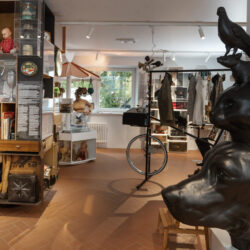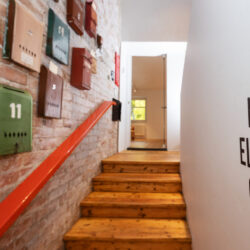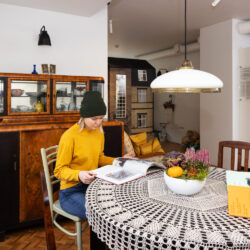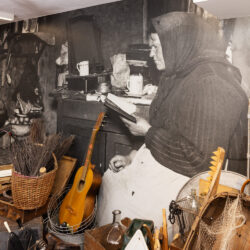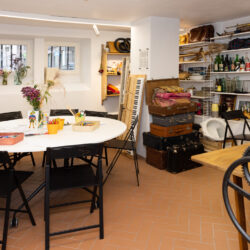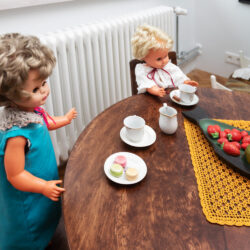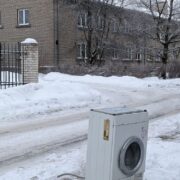About Kalamaja Museum
Since the very first moment, the Kalamaja community museum has been a joint project with the people of the area. Such method of creating a museum is unique in Estonia. The museum started in the spring of 2018 with a survey conducted among locals, which revealed that people are interested in hearing stories about yesterday, today and tomorrow and they want a nice place where the community could meet. This was followed by brainstorming and meetings with former and current residents of Kalamaja, which laid the basis for the concept and permanent exhibition of the museum. Tens of former and current residents of Kalamaja have participated in the setting up of the exhibition by donating items and sharing their memories of the life in Kalamaja.
The Kalamaja museum summarises only a fraction of the colourful nature of the area. The whole story of the oldest suburb of Tallinn from its beginning to the end is not told between the museum walls. Kalamaja is for immediate enjoyment. It can briefly be experienced in the museum, but first and foremost by walking on the streets and in the parks, sitting on benches or stairs of the area.
The permanent exhibition of the museum ‘A Village in the Middle of the City’. Stories about Kalamaja” speaks of the life of the area through six personas characteristic to Kalamaja: a man of Kalamaja, a child of Kalamaja, a parent of Kalamaja, a life artist of Kalamaja and an animal of Kalamaja. These characters are a summary of different times and eras and tell the story from the Middle Ages to today. Walking through the museum will open the stories of the houses of the area together with the local people: the visitor is welcomed in the cellar, corridor, garage, living room, but you can find exhibitions in the toilet as well. Young visitors can play in the dollhouse that depicts the Tallinn-type house in the family area of the museum.
In the museum you will find a gallery where locals and others can form their ideas into exhibitions or present interesting collections to wider audiences.
The museum is big on its contents, but small in cubic meters. Therefore you can often see our exhibitions also on the streets of the area.
Many thanks to all the people of Kalamaja who helped to create the museum!
Kalamaja Museum is the Silletto Prize for Community Participation and Engagement at the 2024 European Museum of the Year Awards winner.
Curators: Kristi Paatsi, Tuuli Silber, Laura Jamsja
Space design: Ruumilabor OÜ
Graphic design: Refleks OÜ
Exhibition solutions: HN Steel, Argo Männik, Krista Norden
The temporary exhibitions hall of the Kalamaja Museum is featuring an exhibition “The Magical Realism of Kopli”
The exhibition focuses on peculiarities and special observations in one of Tallinn’s districts. The visitor gets a subjective view of Kopli. The exhibition was inspired by two women’s perceptions of what they have experienced and heard in Kopli. One of the authors comes from several generations of locals, while the other author has lived in Kopli for only a few years. However, there are as many stories about Kopli as there are people to tell them. The exhibition explores reality through people’s experience and perception of life. It tackles the question of what a dreamed and forgotten Kopli looks like, while also trying to capture the magic of everyday life.
The exhibition is part of Kalamaja Museum’s series of exhibitions curated by members of the local community. The curator of this exhibition is Hannele Känd, a Kopli resident. It was designed by Linda Zupping, who is also from Kopli.
In addition to the exhibition, visitors can also take part in Kopli tours that set off from Kalamaja.
Curator: Hannele Känd
Room designer: Linda Zupping
Graphic design: Eva Voog
Soundscape: Carmen Kalata
Audio: Andres Roosileht, Eduard Tee
Language editor: Klaire Kolmann
Text translations: Luisa Translation Agency
Producers: Linda Zupping, Mirko Känd, Sandra Mirka
MISSION
The Kalamaja Museum is a community museum that has been created together with the local community for their benefit.
The Kalamaja Museum is a meeting place that welcomes everyone to think and to contribute. It encourages the residents and guests of Kalamaja to discover the colourful history, the fun present and the exciting future of the area.
VISION
The Kalamaja Museum is a living museum that talks and speaks.
It is a supportive place for the active members of the community to carry out their fun ideas.
VALUES
Co-creation
The museum works primarily for the community and with the community. The starting points for exhibitions, workshops and events mostly come from the people connected to the area themselves. In the same way, community members can present their own knowledge, experience, activities and collections through museum tours, exhibitions and workshops.
Everyone is welcome
Kalamaja Museum is a living museum whose greatest value is the members of the community. Who makes up the community? Whether you are young or old, a past or present Kalamaja resident or just a visitor fascinated by this vibrant area, you are always welcome to join our activities.
Innovation and quick response
The world is changing fast and so are we. In our work, we experiment with various innovative and unexpected methods and respond to the processes taking place in the community or society with exhibitions and events.
Museum in the urban space
One of our important starting points is having the museum’s exhibitions, activities and initiatives in the Kalamaja urban space in order to always be closer and present in the community without them having to visit the museum’s building. The Museum is an organic part of Kalamaja, at all times.
CREATION OF THE COMMUNITY MUSEUM
How is the Kalamaja community museum being created? Part I
Here we would like to introduce the concept of the Kalamaja Museum and to give an overview of the preparation process.
It will be the first museum in Estonia that has been developed together with the community from the beginning. Input for the concept of the permanent exhibition was given by former and current residents of Kalamaja during brainstorming.
We offer the locals and visitors a fun opportunity to become acquainted with the history, current life and future of the area through exhibitions and programmes for the public. The museum will become a cosy place where to meet, discuss, hold different workshops, concerts, poetry nights, shows, and show to the public the exciting collections of local people as well as hold birthday parties. The museum also serves as an example platform for other communities.
How the museum came to be
The foundation of the Kalamaja Museum of the Tallinn City Museum as a community museum has been a multi-faceted process, the participants of which are people living in Põhja-Tallinn, friends of Kalamaja and other interested people. The settlement that dates back to the late Middle Ages has a united and active community that has been interested in a museum that would showcase their district. This would open the history of one of the oldest suburbs of Tallinn to the older and younger residents and would give an overview of the story of the area at large. It would also be an exciting starting point for tourists or a pit-stop on a journey discovering Kalamaja.
The Children’s Museum that resided in the building before was aimed at a narrower target group and desperately needed a makeover. Compared to the other children’s museum of the Tallinn City Museum in Kadriorg, the number of visitors was much lower. Additionally, the functions of the museums partially overlapped. Therefore, the management of the City Museum had a vision that the target groups must be expanded, and the museum must be restarted.
The Tallinn City Museum opens the multiple angles of the history, eras and settlements of the City of Tallinn. One of the long-term projects has been to study the suburbs. The first project of this kind was the Telliskivi pop-up museum in 2014, which was set up at the Telliskivi Creative City together with the community.
Read more here: http://telliskivimuuseum.weebly.com/.
The second project has been aimed at collecting and showcasing the history of Mustamäe. In the future we hope to introduce other settlements of the capital in the temporary exhibits area of the opened museum.
Despite several earlier cosmetic repairs over the years, the building at Kotzebue 16 was in a dire state. The renovation works started already during the time of the director before the last. It was decided to close the building for visitors for several reasons – first, the façade renovation was carried out in 2018 and due to the construction peculiarities of the building, it would have been difficult to receive visitors. Secondly, the decision was influenced by the poor sanitary condition – in 2018, the water pipes of the building leaked on several occasions (despite the emergency repairs), causing damage to the museum objects in the storage facilities in the basement of the building. As the building should have been emptied for engineering surveys before the indoor construction works started, it was decided that the closing should not be delayed. In the spring of 2019, after several months of preparations, the museum objects in the storage rooms of the building were moved to the new rented premises, after which the engineering survey was commissioned for the building. As the building is old (built in 1934) and was damaged by fire in 1944, the walls and floors were opened three times in order to establish the condition of the building. Thereafter, the architectural drawings and projects for restoring the rooms could be ordered and preparations for installing the new permanent exhibition are started.
At the moment the procurement for construction is ongoing; the period for the planned construction works is September 2020 – May 2021
The stages of the process of creating the Kalamaja Museum
Survey in the community and outside
The process of creating new content for the building at Kotzebue 16 started during the first half of 2018 when we carried out a survey amongst different groups, asking, what the community thought of the idea of the new museum, if this topic is of interest and what sort of museum they would like to see. The first activity was organised in May 2018 during the Kalamaja days when people could fill in questionnaires at the museum (its location was also in the epicentre of the event). This was followed by a web questionnaire, which was shared with the community’s Facebook groups on several occasions. Over 200 people responded to the survey. The results revealed that people would like to have a nice and cosy place where they can become acquainted with the present and past of Kalamaja. It would be a meeting place and a child- and family-friendly place where time could be spent together. Based on the results of the survey, we have prepared our action plan.
Meetings with community members and representatives
As the main target group of the Kalamaja Museum is local residents, the key activity for the development of the museum has been discussions and interviews. First, a meeting with the representatives of the Telliskivi Selts, that brings together the more active members of the community, took place in January 2019. Furthermore, we organised discussion evenings to give all the stakeholders an opportunity to speak and to participate in the creation of the museum.
Three meetings took place at the beginning of the year 2019. Based on thought exercises and various inclusion tasks, summaries and idea maps were prepared, which are the basis of the ideas of the permanent exhibition and concept of the museum. It was nice to see that Kalamaja is important for people of different backgrounds – the participants in the brainstorming were young people as well as senior citizens, those who had recently moved to the area as well as people who lived there during the 1930s-1940s. The feedback from the meetings highlighted that this museum has been expected and is wanted. Younger people emphasised the importance of the museum as a meeting place and its suitability for families. For the more senior residents of Kalamaja, participating in the museum’s process has given an opportunity for self-expression and self-realisation. In addition to the brainstorming sessions, regular meetings with the representatives of institutions/organisations important for the community, such as Kalamaja library, Põhja-Tallinna district government, youth centres, Kalamaja schools and kindergartens, Kalju church, Sustainable Renovation Centre (SRIK), Telliskivi Creative City, etc., took and will be taking place. We are trying to reach as many parties as possible who could contribute to the creation of the museum with their opinion. As a community museum is a living and developing environment, the meetings will continue even after the museum has been opened.
Additionally, the people who participated in the meetings and brainstorming have highlighted that the Kalamaja Museum could offer rooms for the communities of other districts. The Kalamaja Museum as the museum for suburbs is a concept that fits well with the Tallinn City Museum’s direction to study suburbs and districts (e.g. Kopli, Pelgulinn, Lasnamäe).
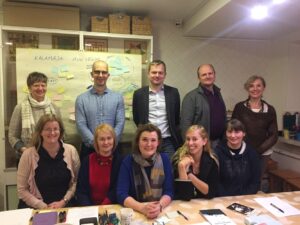
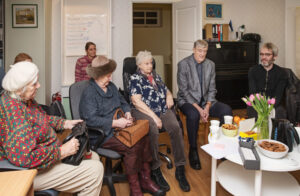
The ideas of the locals grew into the idea of a permanent exhibition
The entire idea of the permanent exhibition of the Kalamaja Museum is based on the meetings and brainstorming sessions created by people themselves. The locals gave an input that the permanent exhibition of the Kalamaja Museum could open the stories of Kalamaja from the Middle Ages to today, through the types of people characteristic for Kalamaja.The stories and opinions of the residents of Kalamaja highlighted the following categories: Kalamaja ancestry, Kalamaja childhood, Kalamaja woman, Kalamaja man, Kalamaja artist of life, Kalamaja animal, Kalamaja so-called empty character. Through the types of people, we will be opening the stories of different people of all ages and display items, photos, museum objects etc received from people as donations. The room of the so-called empty character will become an engaging exhibition room where people can write their stories, draw and express themselves otherwise on the topics of Kalamaja. The spatial elements of the permanent exhibition are currently being built.
The permanent exhibition level flows through the building, introducing the story of different houses of Kalamaja. The living room will feature a bookshelf, sofa and rest area, and a Kalamaja dollhouse meant for children, which aims at introducing the history of the area through play. The mezzanine, which opens to the terrace (the former garage) will feature the story of Kalamaja garages and visitors can use it for birthday parties/events as it will also have a kitchen surface.The cellar will become a room with a woodpile and laundry kitchen for educational programmes and for larger meetings. Additionally, the museum will have a model of Kalamaja.
The first temporary exhibition of the museum will be an overview of the history of Kalarand up to the present day. It is an exhibition for educating citizens on the topic of Kalarand, which, as an area, is interesting for locals as well as for larger target groups. The exhibition is curated by Teele Pehk and Triin Talk.
In the future, the area for temporary exhibitions will be open also for other communities (Kopli, Lasnamäe, Pelgulinn) with satellite exhibitions in the respective district.
The interior design partners of the museum are designers from the Ruumilabor agency. Graphic design is created by the design agency Refleks. We have presented the developed plans to the members of the community and their suggestions and comments have been sent to the designers.
The largest part in the preparation process for the museum has been preserving and collecting the community heritage.
Simultaneously with the brainstorming, the work of interviewing the members of the community and of collecting photos and items for the new museum (including supplementing the collections of the Tallinn City Museum) started at the beginning of 2019. We have conducted tens of in-depth interviews, which have been recorded as audio files and transcribed for the museum’s archive. The interviews have given us valuable input for creating the content of the museum. Among those interviewed are families who have lived in Kalamaja for several generations, former residents as well as new community members. Furthermore, we have collected images from personal albums of people, which have largely supplemented the photo archive of the City Museum. We also initiated a collection campaign to highlight items in the collection that would be donated by community members and that are important for them. Additionally, our display includes items from the rich collections of the Tallinn City Museum.
There was a separate plan of action for collecting house numbers, street signs and mailboxes for the corridor exhibition. For the WC exhibition, we call for people to donate toilet seats. The aim is to illustrate former modest sanitary conditions, where very often, several families had to use a common toilet in the corridor of their house. We inform people of the collection of donations and stories at our homepage, Facebook page and on the information stand in front of the museum building, which we erected in order to inform those people who do not use the internet. We also have a good cooperation with the local media of the Põhja-Tallinn district.
The museum is also promoted via videos where the people who participated in the creation process open their stores. You can see the first clips of the series here:
https://www.youtube.com/channel/UC52s43q1TWuGJa1asE6lK1Q.
Inclusion of different target groups
One of the important target groups is children and families, and therefore, we have actively included young people and children, schools and kindergartens of the area into the development process. We announced the collaborations collection campaign, the aim of which was to really use the contribution of the young people. We suggested different topics and formats, which in the future will be used in the content of the museum in different formats (on pillows, curtains, various activities for children etc). The museum received over 200 works – 157 pictures, 47 written pieces, sculptures, games etc. In their wood workshop, the pupils of the Kalamaja school made scooters using the instructions of the slum boys of the past, which they used to race around in Kalamaja. It will be possible to use them in the future to test your speed at the yard of the museum! The drawings and written pieces of the children were used to create a public exhibition in the tunnel of Balti Jaam “In the Sauce of the Children of Kalamaja”, the original works are displayed in the Kalamaja library near the museum. As a sign of gratitude, all the participating groups were taken on a playful tour around the streets of Kalamaja in order to introduce the history of their home district to the children. We developed three different routes according to the age and composition of the group. The tour included various activities, such as playing the old children’s games in the park or tasting dried fish. The museum has a good neighbourly relationship with the Gustav Adolf Grammar School next door.

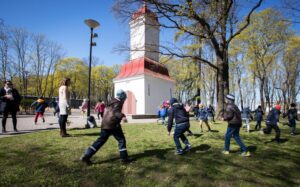
In February 2019, we introduced the museum in the neighbouring settlement, the old Community House of Kopli for two weeks. There, at the exhibition on covers of vinyl records of the Estonian National Archive, we carried out workshops and listened to old records for children and invited people to participate in the creation of the museum.
During the 2019 Kalamaja Days and Museum Night we carried out a number of activities that provided information on our activities to community members as well as to other interested parties. We organised two Kalamaja children’s tours for families, Kalamaja city fauna tours and a Kalamaja ghost tour, which, with more than 130 participants, proved to be the most popular. For the ghost tour, we received input from elderly locals who told stories of their childhood and later years. During the Kalamaja Days, we collected ideas and drawings on what the museum’s logo could look like at the tent by the Salme Cultural Centre.
During the cafés day of the Kalamaja Days, we organised the food for thought café in the museum yard, where the guests could, in addition to good food, order personal written pieces of different styles from the writer who was present. The styles included love poetry, personal advertisements, letter of praise or explanation. Writer Jan Kaus read selected extracts from the works of writers related to Kalamaja Additionally, an artist drew pictures on the chosen topics right under the eyes of the guests. The fences featured an outdoor exhibition on old photos of Kalamaja and children’s drawings.
The abovementioned activities helped to spread information on the museum and its creation beyond the community. There were hundreds of people present; most of them received a personal introduction to the plans. That way we created several contacts with former and current locals who agreed to share their memories and items with the museum.

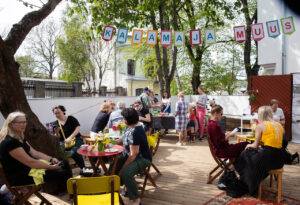
Collectively selected CVI
We wanted to create the visual identity of the museum as a very important communication element aimed at the public, together with the community and stakeholders. We especially wanted to emphasise the lively fantasy of children and young people, which often offers non-standard and unexpected solutions. For that purpose, we brought together the children’s works made during the inclusion project as well as during the Kalamaja Days and sent them for inspiration to our partner design studio Refleks. Additionally, someone from the design team was always present at the meeting evening with the community representatives. Four versions were made, which were put to public vote via the museum’s Facebook page, homepage and information stand in front of the house (paper votes into mailbox). Participation in the voting was higher than expected – in total 555 persons voted. The selected visual identity and logo, which featured a fisheye, received 222 votes. “Kala” means fish in Estonian. This is a view on the museum’s name, which is opened through the eye of a curious fish – an accurate and expressive shift to characterise the entire content of the exhibition and museum. Graphically simple, bold and innovative. The logo and graphic elements, which are used in the museum’s materials, are processed with the fisheye effect. This is a wide-angle lens, which is used for taking photos of panoramic, demi sphere-shaped and other images of a disfigured perspective. The aim of choosing the logo was to involve as many members and friends of the community in the process of creating the museum as possible, as well as to empower their part in the creation of the museum. In the context of the Estonian museum scene it is surely something new and unexpected. All the CVI designs that were submitted for voting can be seen here: https://linnamuuseum.ee/catkalamaja/aita-kalamaja-muuseumil-logo-valida/. The selected CVIs can be seen here: https://linnamuuseum.ee/cat-kalamaja/kalamajamuuseumi-logo-kavand-valitud/
Museum extends to the urban space
One of the goals of the Kalamaja Museum is to be visible in the city. In cooperation with the Photo Month, an outdoor exhibition “Where No Ray of Sun Shines” (3 October-4 December 2019) was created, focusing on the photo series of photo reporter Hans Soosaar about the apartment situation in Kalamaja in the 1920s. Being the first of such activities , the exhibition highlighted a comparison of today’s Kalamaja and the life back then. Ten stands were installed on the streets with Soosaar’s photos and descriptions of the conditions from the backs of the photos. The location was the front or surroundings of the same buildings the residents of which were photographed by Soosaar over 90 years ago. That turned into a unique city gallery. The outdoor exhibition was born in cooperation with the local apartment associations who gave their permission to place photo stands in front of their houses. We received a lot of positive feedback; people were happy that the exhibition will bring more colour to the urban space and they found that there could be more of such actions. Additionally, the exhibition helped the residents of the houses to meet each other and bring the community together. The outdoor exhibition included three city hikes, which proved to be extremely popular. In total, 40-60 people participated in each tour.
We have taken the goal of creating similar outdoor exhibitions in the future.
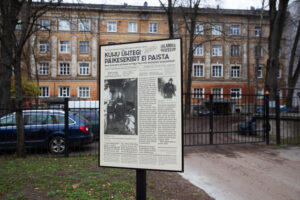
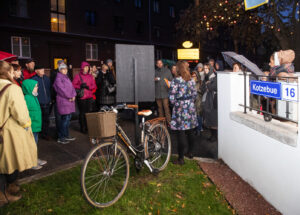
At the beginning of 2019, we invited the children of Põhja-Tallinn to send in works on different topics such as “My favourite place”, “My pet”, “If Kalamaja had a museum, what should it feature?”, “What could be the mascot of the Kalamaja Museum?”, “What could the future Kalamaja look like?”
In total, the museum received over 160 pictures-sketches and 54 pieces of writing, including a plan for an urban hike, one small sculpture, two oil paintings and two models. In order to decorate the cold urban space of the Balti Jaam tunnel that connects the Old Town and Kalamaja, the walls of the tunnel feature an exhibition of the children’s works sent to the Kalamaja Museum from October 2019. All originals are displayed at the Kalamaja library at Kotzebue 9.
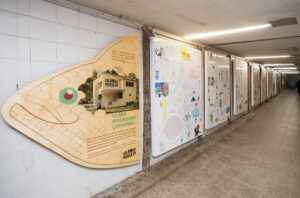
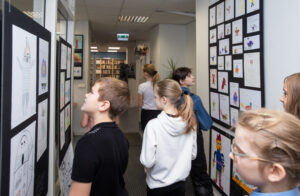
We will keep you informed about our progress in creating the museum.
Your stories, objects, photos and letters on Kalamaja are always welcome.
Kristi Paatsi, Tuuli Silber, Laura Jamsja










































